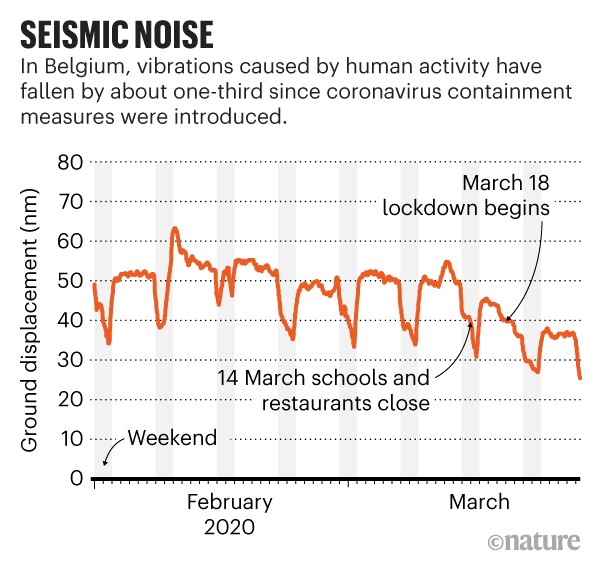Hello Nature readers, would you like to get this Briefing in your inbox free every day? Sign up here

Source: Royal Observatory of Belgium
Coronavirus lockdowns have changed the way Earth moves. Researchers who study Earth’s movement are reporting a drop in seismic noise — the hum of vibrations in the planet’s crust — that could be the result of transport networks and other human activities being shut down. The data shown above are from the Royal Observatory of Belgium in Brussels, and the effect might be a lot less apparent at stations that are purposefully located in remote areas or deep boreholes to avoid human noise.
21,000 to 120,000
The estimated number of deaths that have been averted in 11 countries in Western and Northern Europe because of infection-control measures such as national lockdowns. (Nature | Continuously updated)
Features & opinion
The future of collaborative writing
A growing suite of tools allows teams of researchers to work collectively to edit scientific documents. Discover systems including Manubot, Overleaf, Authorea, Fidus Writer and Manuscripts.io that will help you to “walk the walk of open science”, in the words of computational biologist Olga Botvinnik. You can also explore an example Manubot project to get the ball rolling.
How to defend a PhD remotely
Back in November 2019, before the coronavirus outbreak began, marine biologist Alyssa Frederick successfully defended her thesis remotely on Zoom. Her advice is to have patience with others, manage expectations and practise putting all the pieces together ahead of time — and don’t forget to celebrate afterwards.
“His fingerprints are everywhere”
Philip Anderson, one of the most influential theoretical physicists of the twentieth century, died on 29 March, aged 96. The Nobel laureate specialized in condensed matter, and his concept of ‘Anderson localization’ of electrons explains everything from how fog reflects light to why non-crystalline metals are electrical insulators. Anderson was also a forceful opponent of reductionism, and he spelled out his vision in his influential 1972 Science essay ‘More Is Different’. “Anderson was the pre-eminent condensed-matter theorist of his day — a day that lasted for over 50 years — and his fingerprints are everywhere,” says physicist Nigel Goldenfeld.
Read Philip Anderson’s review of Robert Laughlin’s book A Different Universe: “My message is this: buy the book.” (Nature, from 2005)
35
The number of hadrons — particles made of two or more quarks — discovered by the Large Hadron Collider (LHC) at CERN, with the latest one, called Ξc(2923)0, added on 30 March. (Elementary particles are much rarer finds: the last one was the Higgs boson, which the LHC discovered in 2012.)

